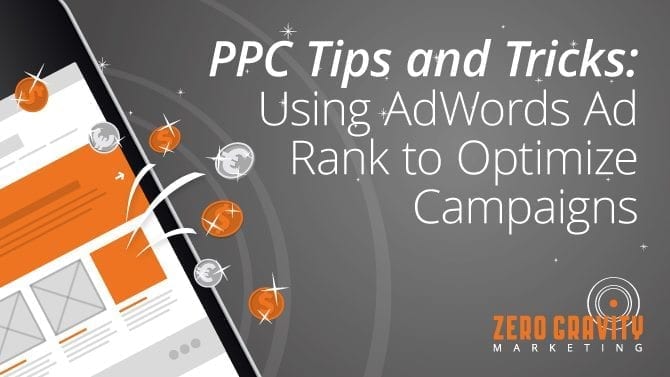
Improve Conversions With Better PPC Advertising Based on Google’s Ad Rank
AdWords’ ad rank is all about quality and relevance. Businesses that take time to decipher the various ad rank components will dramatically optimize the success of their campaigns, as well as improve their conversions and pay per click (PPC) success. The more successful the pay per click ad, the less cost per click (CPC) you pay as an advertiser – and that’s a win for you and the target customer.
AdWords Ad Rank
Your Ad rank either increases or decreases the visibility and accessibility (or reach) of an ad to its intended consumer audience. Placement is usually determined through the culmination of quality score, bid, relevance, and advertising extensions, to name a few. AdWords’ unique system rates and breaks down three specific components relevant to each score. Each is given a rating of either below average, average, or above average. These ratings are a great way to highlight areas needing the most improvement.
Boosting Ad Rank
Ad relevance, expected click-through rate (CTR), and landing page experience, are the three high-quality components that directly improve AdWords ad rank and quality score.
Ad Relevancy
Typically, high ad position reflects a high-quality ad. Ad relevance is an overlooked, albeit integral, aspect of increasing an ad’s quality score and overall campaign performance. AdWords’ ad rank compares the relevancy of data in an ad to its intended query to determine if it should have a higher placement (or position) on a page. The more specific and focused the content, the more relevant it will be within that particular context. This makes it easier and quicker for advertisers to hit their target market consumer and increase PPC.
Tips for improving ad relevance include creating context-specific keywords for queries, using main keywords in uniform resource locators (URLs) and ad titles, as well as utilizing smaller ad groups with fewer keywords to increase conciseness and limit confusion. Ultimately, the more relevant the ad is to the landing page the better.
Expected CTR
Expected click-through rate measures the probability that an intended consumer will click on an ad based on specific keywords or search terms used. This measurement also considers an ad’s history of clicks and ad position. Relevant-to-context keywords are an important part of successful CTR predictions. Improving this quality component means an ad is more likely to increase its ad rank performance and quality score.
Tips for improving expected click-through rate include making sure your keywords reflect the content of your web page, use of active keywords versus paused keywords to determine the most recent and accurate score, as well as identifying empty and irrelevant keywords.
Landing Page Experience
A positive landing page experience essentially means that an ad did its job – very well. The more relevant, easy to understand, and simple to navigate a landing page is, the higher it will rank on the page. Likewise, a poor landing page experience will receive a lower ad rank and quality score because it is less likely to fulfill the promise of an ad and satisfy the customer. Strategic web design is one way you can improve your landing page experience for users.
Additional tips for improving landing page experience include meeting the customer’s needs and expectations gleaned from the ad, thorough display of product knowledge, use of relevant and up-to-date information and sources that are easy to understand and find, a sense of trust and transparency, mobile-friendly apps, and limited pop-ups.
There are many more ways to improve your pay-per-click advertising and ad rank (relevancy, expected CTR, and landing page experience). Understanding ad rank components is the most effective way to improve conversions, ad position, and quality score.
Contact Zero Gravity Marketing for more information.








